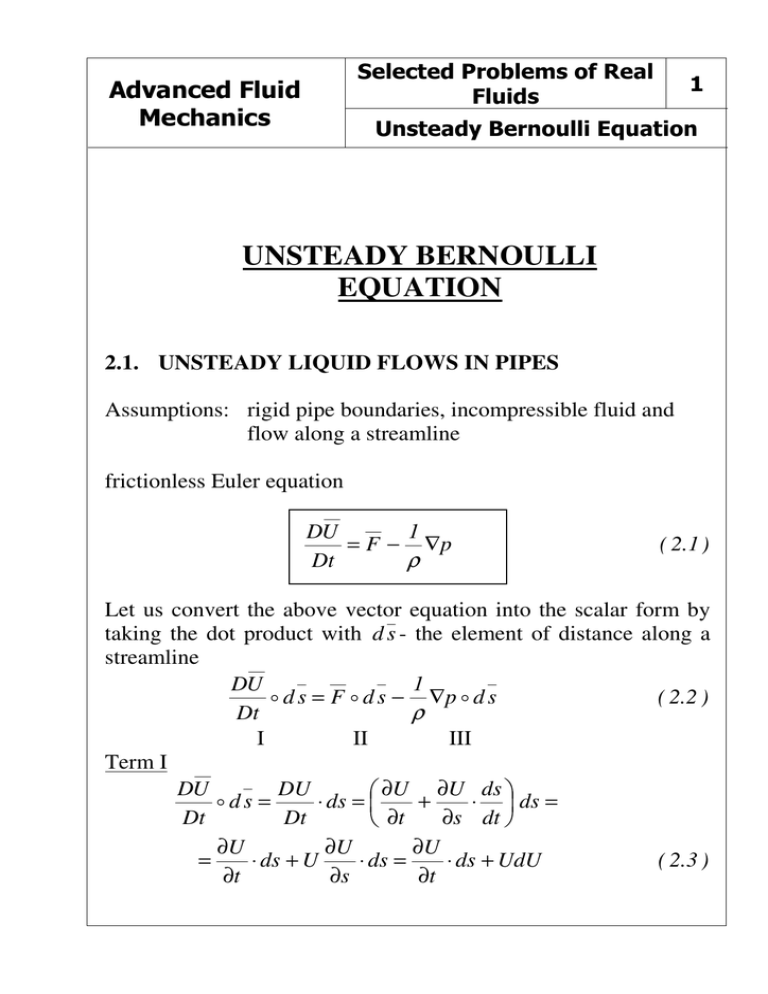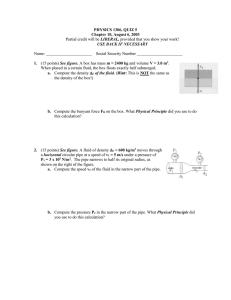UNSTEADY BERNOULLI EQUATION
advertisement

Selected Problems of Real F lu i ds Advanced Fluid M ech anics 1 U n steady B ern ou lli E q u ati on UNSTEADY BERNOULLI EQUATION 2.1. UNSTEADY LIQUID FLOWS IN PIPES Assumptions: rigid pipe boundaries, incompressible fluid and flow along a streamline frictionless Euler equation DU 1 = F − ∇p Dt ρ ( 2. 1 ) Let us convert the above vector equation into the scalar form by taking the dot product with d s - the element of distance along a streamline DU 1 o d s = F o d s − ∇p o d s ( 2.2 ) Dt ρ I II III Term I DU DU ∂U ∂U ds o ds = ⋅ ds = + ⋅ ds = Dt Dt ∂ t ∂ s dt ∂U ∂U ∂U = ⋅ ds + U ⋅ ds = ⋅ ds + UdU ( 2. 3 ) ∂t ∂s ∂t Advanced Fluid M ech anics Selected Problems of Real F lu i ds 2 U n steady B ern ou lli E q u ati on Term II Assuming the potential character of the mass forces field ∂Φ ∂Φ ∂Φ F = ∇Φ = i+ j+ k ∂ x ∂ y ∂ z ( 2. 4 ) Thus ∂Φ ∂Φ ∂Φ F o ds = i+ j+ k o (dx ⋅ i + dy ⋅ j + dz ⋅ k ) = ∂ x ∂ y ∂ z ∂Φ ∂Φ ∂Φ = dx + dy + dz = dΦ ( 2.5 ) ∂x ∂y ∂z For gravitational mass forces field ∂Φ ∂Φ ∂Φ = Fx = 0 ; = Fy = 0 ; = Fz = − g ∂x ∂y ∂z So finally F o d s = dΦ = ∂Φ ⋅ dz = − g ⋅ dz ∂z ( 2.6 ) ( 2. 7 ) Term III ∂p ∂p ∂p ∇p o d s = i + j + k o (dx ⋅ i + dy ⋅ j + dz ⋅ k ) = ∂y ∂z ∂x ∂p ∂p ∂p = dx + dy + dz = dp ∂x ∂y ∂z ( 2. 8 ) Advanced Fluid M ech anics Selected Problems of Real F lu i ds 3 U n steady B ern ou lli E q u ati on Utilising expressions (2.3), (2.7) and (2.8) leads to the following form of Euler equation U 2 ∂U dp ds + d = − g dz − ∂t ρ 2 ( 2. 9 ) Integration along a streamline from point 1 to point 2 leads to Bernoulli equation for unsteady flows ∫1 2 2 dp U 22 − U 12 ∂U ds + + g ( z 2 − z1 ) + ∫1 =0 ∂t 2 ρ ( 2.10 ) For incompressible fluid ρ=const 2 ∂U U 12 p1 U 22 p2 + + g ⋅ z1 = + + g ⋅ z 2 + ∫1 ds 2 ρ 2 ρ ∂t ( 2.11 ) example A long pipe is connected to a large open reservoir that is initially filled with water to a depth of H. The pipe is D in diameter and L long. As a first approximation, friction may be neglected. Determine the flow velocity leaving the pipe as a function of time after a cap is removed from its free end. The reservoir is large enough so that the change in its level may be neglected. cross section A cross section B zA = H pA = pa UA = 0 zB = 0 pB = pa UB = ? Advanced Fluid M ech anics Selected Problems of Real F lu i ds 4 U n steady B ern ou lli E q u ati on Bernoulli equation along a streamline from A to B B ∂U U B2 gH = + ∫A ds 2 ∂t ( 2.12 ) assumption: velocity in reservoir may be neglected except for a small region near the inlet to the tube ⇓ ∫A B B ∂U ∂U ds ≈ ∫0 ds ∂t ∂t ( 2.13 ) from continuity equation implies that in the tube U=UB everywhere, so that ∫0 B B dU dU B ∂U B ds = ∫0 ds = L ∂t dt dt ( 2.14 ) Advanced Fluid M ech anics Selected Problems of Real F lu i ds 5 U n steady B ern ou lli E q u ati on Substitution gives U B2 dU B gH = +L 2 dt ( 2.15 ) dU B dt = 2 gH − U B2 2 L ( 2.16 ) Separating variables and integrating ∫0 UB = we have dU B U1 1 -1 = tgh 2 gH 2 gH − U B2 2 gH UB 1 tgh -1 2 gH 2 gH UB tgh −1 2 gH t dt = ∫ 0 2L UB = 0 ( 2.17 ) 2 gH ⋅ t = 2L ( 2.18 ) and finally 2gH ⋅ t U B = 2 gH tgh 2L ( 2.19 ) Selected Problems of Real F lu i ds Advanced Fluid M ech anics dU B dt = t =0 6 U n steady B ern ou lli E q u ati on gH ⋅ L cosh 1 2gH ⋅ t 2L = gH L ( 2.20 ) t =0 the equation of the tangent to the UB distribution for t≈0 UB(t ) = gH t L ( 2.21 ) the time constant of the dynamic system T= 2L 2 gH ( 2.22 ) applying T the expression describing the time evolution of the velocity UB may be written in simplified form U B = 2 gH tgh(t / T ) ( 2.23 ) Advanced Fluid M ech anics Selected Problems of Real F lu i ds 7 U n steady B ern ou lli E q u ati on 2.2. FLOW OF COMPRESSIBLE LIQUID THROUGH THE ELASTIC PIPE – "WATER HAMMER" Continuity equation for the pipe with varying cross sectional area A ∂( ρA ) ∂ + ( ρUA ) = 0 ∂t ∂s for compressible liquid dp = − k dv dρ =k v ρ ( 2.24 ) ( 2.25 ) where k is the modulus of volume elasticity of liquid assuming linearity p − p0 = k ρ − ρ0 ρ0 p − p0 ⇒ ρ = ρ0 1 + k ( 2.26 ) cross sectional area of the elastic pipe p − p0 D A = A0 1 + ⋅ E δ ( 2.27 ) where: A0 - cross sectional area under reference pressure p0 E - modulus of volume elasticity of pipe wall D - pipe diameter δ - pipe wall thickness let us rewrite continuity equation into the form ∂( ρA ) ∂p ∂( ρUA ) ∂p ⋅ + ⋅ =0 ∂p ∂t ∂p ∂s ( 2.28 ) Selected Problems of Real F lu i ds Advanced Fluid M ech anics 8 U n steady B ern ou lli E q u ati on substituting (2.26) and (2.27) into the above and neglecting the terms of the second order we obtain ρ 0 A0 + 1 k 1 D ∂p 1 1 D ∂p ⋅ + ρ 0 A0U + ⋅ + E δ ∂t k E δ ∂s ∂U + ρ 0 A0 =0 ∂s ( 2.29 ) and finally ∂p ∂p +U + ρ0 ∂t ∂s ∂U =0 1 1 D ∂s ρ 0 + ⋅ k E δ 1 ⋅ ( 2.30 ) let us introduce the speed of small disturbance propagating in elastic pipe and compressible liquid c2 = 1 ρ 0 + 1 k 1 D ⋅ E δ ( 2.31 ) the system of equations governing the flow (continuity and Euler equations) ∂ p ∂ p ∂U + U + c =0 ∂t ρ 0 ⋅ c ∂s ρ 0 ⋅ c ∂s ∂U ∂U 1 ∂p +U + =0 ∂t ∂s ρ 0 ∂s ( 2.32 ) Advanced Fluid M ech anics Selected Problems of Real F lu i ds 9 U n steady B ern ou lli E q u ati on let us calculate the sum of the equations (2.32) ∂ p ∂ p ∂ p + U + U + U + c + U = 0 ( 2.33 ) ∂t ρ 0 ⋅ c ∂s ρ 0 ⋅ c ∂s ρ 0 ⋅ c receiving ∂ p ∂ p + U + ( U + c ) + U = 0 ∂t ρ 0 ⋅ c ∂s ρ 0 ⋅ c ( 2.34 ) and their difference ∂ p ∂ p − U + ( U − c ) − U = 0 ∂t ρ 0 ⋅ c ∂s ρ 0 ⋅ c ( 2.35 ) the equations (2.34) and (2.35) may be expressed in the common form DΨ ∂Ψ ∂Ψ =0 ⇒ +a = 0 where ψ = ψ ( s ,t ) Dt ∂t ∂s ( 2.36 ) as the so-called wave equation Solution it may be easily shown that any function ψ of the form ψ ( s ,t ) = f ( s − a ⋅ t ) = f ( z ) where z = s − a ⋅ t satisfies the equation (2.36) ( 2.37 ) Selected Problems of Real F lu i ds Advanced Fluid M ech anics 10 U n steady B ern ou lli E q u ati on proof let us calculate the derivatives ∂ψ ∂ψ ∂z ∂ψ = ⋅ =−a ∂t ∂z ∂t ∂z ∂ψ ∂ψ ∂z ∂ψ = ⋅ = ∂s ∂z ∂s ∂z and put them into (2.36) ∂Ψ ∂Ψ ∂ψ ∂ψ +a =−a +a =0 ∂t ∂s ∂z ∂z interpretation The quantity Ψ is propagated in the flow with velocity a. In other words Ψ is kept constant along the line meeting the relation ds/dt = a (2.38) Ψ ( s0 ,t0 ) = Ψ ( s1 ,t1 ) Advanced Fluid M ech anics Selected Problems of Real F lu i ds 11 U n steady B ern ou lli E q u ati on example: Let us consider the flow through a pipe which is connected to a large reservoir. Pressure over a free surface as well as this one at the outlet from the pipe are both equal to p0. Suddenly flow is stopped by the valve. What will happen with the pressures pus and pds propagated up- and downstream the valve ? data: = δ = E = k = ρ0 = H = d 40 mm 5 mm 21 MN/cm2 210 kN/cm2 1000 kg/ m3 0.5 m velocity inside the pipe before shutdown U bs = 2 gH Advanced Fluid M ech anics Selected Problems of Real F lu i ds 12 U n steady B ern ou lli E q u ati on At time t0 (just after the valve was shut down) in the neighbourhood of the valve velocity of liquid elements fell down to zero (U = U0 = 0), but the pressure was still p0. In the same time liquid elements located further from the valve were not yet retarded so their velocities became unchanged (U = Ubs) p ± 2 gH = const ρ0 ⋅ c upstream the valve pus p − 2 gH = 0 ρ0 ⋅ c ρ0 ⋅ c pus = p0 + ρ 0 ⋅ c 2 gH pressure pus propagated upstream is called pressure wave or water hammer due to its high values – it may cause damage of the pipe (the problem of firemen) downstream the valve pds p + 2 gH = 0 ρ0 ⋅ c ρ0 ⋅ c pds = p0 − ρ 0 ⋅ c 2 gH due to great absolute values of the term ρ 0 ⋅ c 2 gH in comparison to atmospheric pressure one may expect unrealistic (negative) values of pds pressure pds approaching vacuum may lead to undesired phenomenon - cavitation Advanced Fluid M ech anics Selected Problems of Real F lu i ds 13 U n steady B ern ou lli E q u ati on velocity of small disturbances c= 1 ρ 0 + 1 k 1 d ⋅ E δ = 1395 m / s pressure change (maximal value) ∆p = pus − p0 = p0 − pds = ρ 0 ⋅ c 2 gH = 4.37 MPa note: The solution is independent of the lengths L1 and L2. The approach presented here was derived for inviscid liquids. Viscosity affects the phenomenon – pressure variations in practical cases are smaller (water hammer becomes weaker) due to dissipation processes





